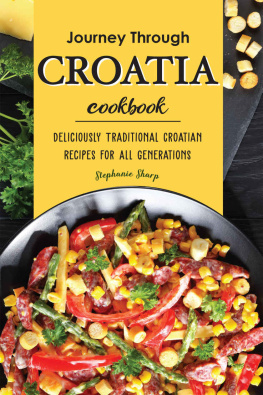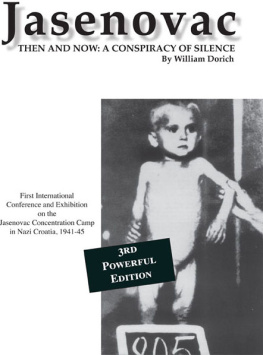Croatia
Croatia
A Nation Forged in War
THIRD EDITION
Marcus Tanner
Yale University Press
New Haven and London
Copyright 1997, 2001, 2010 by Marcus Tanner
First published in 1997
Second edition published in 2001
Third edition published in 2010
All rights reserved. This book may not be reproduce, in whole or in part, including illustrations, in any form (beyond that copying permitted by Sections 107 and 108 of the U. S. Copyright law and except by reviewers for the public press), without written permission from the publishers.
For information about this and other Yale University Press publications, please contact:
U.S. office: sales.press@yale.edu www.yalebooks.com
Europe office: sales@yaleup.co.uk www.yaleup.co.uk
Printed in Great Britain by Hobbs the Printers Ltd, Totton, Hampshire
Library of Congress card number: 2010927225
ISBN 978-0-300-16394-0
A catalogue record for this book is available from the British Library.
10 9 8 7 6 5 4 3 2
Contents
Illustrations
1. Plaitwork above the doorway of the Church of the Holy Cross, Nin (M. Reid)
2. Grgur of Nin, a copy of the original cast in Split made in 1929, by Ivan Metrovi (M. Reid)
(M. Reid)
3. St Donats Church, Zadar (M. Reid)
4. Frankopan fortress at Kostajnica, on the Bosnian-Croatian border (M. Reid)
5. An eighteenth-century print of a Croat (Hrvatski Povijesni Muzej)
6. An eighteenth-century print of a Morlach (Hrvatski Povijesni Muzej)
7. A print of Ban Jela i
i s entry into Zagreb in June 1848 (Hrvatski Povijesni Muzej)
s entry into Zagreb in June 1848 (Hrvatski Povijesni Muzej)
8. The funeral of Stjepan Radi in Zagreb in August 1928 (Hrvatski Povijesni Muzej)
in Zagreb in August 1928 (Hrvatski Povijesni Muzej)
9. Alojzije Stepinac
10. Ante Paveli inspecting troops at Zagreb airport in November 1942 (Hrvatski Povijesni Muzej)
inspecting troops at Zagreb airport in November 1942 (Hrvatski Povijesni Muzej)
11. Paveli and Slavko Kvaternik in Venice for the signing of the Rome Agreement on the NDHs frontiers in May 1941 (Hrvatski Povijesni Muzej)
and Slavko Kvaternik in Venice for the signing of the Rome Agreement on the NDHs frontiers in May 1941 (Hrvatski Povijesni Muzej)
12. A Ustashe poster from 1943 (Hrvatski Dravni Arhiv, Zagreb)
13. A Partisan poster from 1944 (Hrvatski Povijesni Muzej)
14. A Partisan congress of cultural workers near Topusko in June 1944 (Hrvatski Povijesni Muzej)
15. A Communist election poster in 1946 (Hrvatski Povijesni Muzej)
16. Memorial to Cardinal Stepinac, 1960, in Zagreb cathedral, by Ivan Metrovi (M. Reid)
(M. Reid)
17. Vladimir Bakari , in conversation with his master (TitoPartiza, vol. 3)
, in conversation with his master (TitoPartiza, vol. 3)
18. An election poster for Tudjmans HDZ in 1990 (Hrvatski Politi ki Plakat, 194050, published by Hrvatski Povijesi Muzej)
ki Plakat, 194050, published by Hrvatski Povijesi Muzej)
19. The restored statue of Jela i
i in the centre of Zagreb (M. Reid)
in the centre of Zagreb (M. Reid)
20. The devastated centre of Vukovar in 1992 (H. Sheehan)
21. An eighteenth-century monastery in Kostajnica, destroyed by the Krajina Serbs in 1991 (M. Reid)
22. A banner in November 1992 celebrating the first anniversary of the Serbian capture of the town (H. Sheehan)
23. The old bridge at Mostar, destroyed by Bosnian-Croat artillery in 1993 (H. Sheehan)
24. Croats celebrating the centuries-old Sinjska Alka festival in Sinj in 1994 (Chris Helgren)
25. Croat troops near Biograd bombarding Serb positions in Benkovac in August 1995 (Chris Helgren)
26. Croat soldier celebrating the recapture of the Krajina capital of Knin in Operation Storm (Chris Helgren)
27. Croats fleeing Serb-held Drni are reunited with their relatives in ibenik in 1993 (Chris Helgren)
28. A Church in Dubrovnik being boarded up in readiness for Bosnian-Serb shelling in August 1995 (Chris Helgren)
29. Serbs streaming out of Croatia near Petrinja after the fall of the Krajina (Chris Helgren)
30. Tudjman and his defence minister Gojko uak during the election campaign in October 1995 (Chris Helgren)
31. Mr and Mrs Tudjman voting in the election of October 1995 (Chris Helgren)
32. The History of the Croats, 1932, by Ivan Metrovi (M. Reid)
(M. Reid)
Maps
Note on Spelling
In any book about a country that has been ruled by several other countries there are bound to be problems over spelling. In the interests of simplicity I have used the modern Croatian version for all towns and places that lie inside, or partly inside, the present borders of the Republic of Croatia. Thus at all times I have used Rijeka, rather than the Italian word Fiume, Zadar, rather than Zara, Dubrovnik, not Ragusa, Zagreb, not the German word Agram, and Srijem rather than the Serbian word Srem, except where the word is used in a purely Serbian context, that is the Autonomous Region of Slavonia, Baranja and Western Srem. For places and people outside Croatia I have opted for whatever form seemed to be most appropriate or most familiar to an English-speaking reader. For the joint kings of Hungary-Croatia I have used English versions of the names wherever possible, for example Charles Robert, and the Hungarian name elsewhere, e.g. Kalman. Maria is perfectly well known, however, so I have not used Mary when referring to the Hungarian queen. On the same principle I have kept Charles V and Prince Paul in English, but used Franz-Jozef and Karl for the last two Habsburg emperors. I have generally referred to the Habsburgs as emperors, even though the Habsburgs were the kings of Hungary and Croatia.
Preface
In 1992 Croatia joined the club of sovereign European states. It was, said President Franjo Tudjman, the fulfilment of the Croats thousand-year-old dream of independence. Few dreams have been fulfilled in such unpromising circumstances. Recognition of the countrys independence was enmeshed in controversy, for while Germany supported it, Britain and France were strongly opposed. And while Europes statesmen quarrelled over whether Croatia should be recognised at all, the country remained in the throes of a bloody war of independence against the Yugoslav army, the army of the Croatian Serbs and a variety of Serbian paramilitary groups. Fighting had devastated the country and left it effectively partitioned. From Karlovac in the north to the outskirts of Zadar on the Adriatic Sea, a long swathe of hilly territory had fallen under Serb control. Alongside two smaller chunks of land which the Serbs held in eastern and central Croatia, the Serbs had siezed almost a third of the republics territory.
The fighting had ruined the economy of what had once been the richest of Yugoslavias six republics. The main railway lines running east and south of Zagreb were cut; likewise the Autoput Bratstvo i Jedinstvo, the Motorway of Brotherhood and Unity, which ran in a straight line across the flat plains of Slavonia from Zagreb towards Belgrade. Oil pipelines, refineries, power stations and water supplies had been blown up, or had been put out of action, because they lay partly in Serb-held territory. The once prosperous tourist resorts on the Dalmatian coast had been abandoned by holidaymakers, their rooms now crammed with refugees. Most suffered from a chronic shortage of electricity. Even the Pearl of the Adriatic, Dubrovnik, had been badly damaged by Yugoslav army shelling. People had been driven from their homes. About 300,000 Croats had fled westwards from the Serbs to take refuge on the Adriatic islands, in deserted coastal hotels or in improvised camps. A smaller number of Serbs had gone east, either to Serb-held territory in Croatia, or to Serbia proper. Hundreds of villages had been bombed and burned beyond repair and recognition. On the banks of the Danube the eastern town of Vukovar ressembled a smaller version of post-war Dresden or Warsaw. The town had been pounded almost to the ground in a punishing three-month siege by the Yugoslav army and Serb paramilitaries, which ended only with the towns surrender to the Serbs in mid-November 1991.
Next page














 (M. Reid)
(M. Reid) i
i